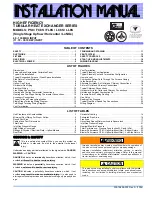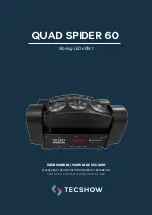
PAGE 2
NOTE: The crane MUST be kept clean and dry and must be maintained in accordance with these instructions.
4.1.
Lubrication.
a)
oil all working parts monthly.
b)
the ram is filled with oil and should only require occasional topping up. for the occasional top up Do not use brake fluid, as this will
damage the hydraulic seals. Proceed as follows:
a)
use only good quality hydraulic jack oil available from your supplier.
b)
Do not oVErfILL as this will cause failure.
c)
After filling with hydraulic oil, pump the crane up to full height and pour off any excess oil.
4.2.
Inspection and Examination of Crane Before Use.
a)
Before each use of the crane you must perform an inspection for leaks, damage, loose or missing parts.
b)
the workshop crane must be examined immediately if it has been subject to an abnormal load or shock. It is recommended
that such an examination is made by an authorised service agent.
c)
the owner and/or operator must be aware that repair of this equipment will require specialised knowledge and facilities.
It is recommended that an annual examination of the workshop crane is made by an authorised service agent.
d)
unauthorised parts may be dangerous and will invalidate the warranty.
Note! Please see the Definition of ‘inspection’ and ‘examination’ below.
Inspection:
Looking at the crane for defects and checking the operation of the controls, limiting and indicating devices without loading the crane.
this is much more than a check but does not normally require any part of the crane to be dismantled other than removal or opening
of covers or housings.
Examination:
Verification that the crane can safely continue in service including a functional test of all safety devices i.e. limiting, indicating
equipment, brakes, clutches, safety valves etc to verify that they operate within the required tolerances. An examination is more
thorough than an inspection.
3. SAFETY/OPERATING INSTRUCTIONS
3.2
OPERATION. (Refer to Section 4.2 (a) regarding inspection before each and every use).
a)
turn the release valve (fig.1) fully clockwise.
b)
Pump the handle to raise the jib to the appropriate height at which the load may be secured.
c)
connect the crane hook to the load using a suitable
certified
sling or support beam. Ensure you are aware of the load weight,
and check that it is within the capacity of the crane (at the jib extension you are using) and the sling or support beam. When removing
engines ensure you know the weight to be lifted. use only the lifting points recommended by the vehicle manufacturer
.
d)
Lift only from directly above the load.
WARNING! DO NOT
lIfT ThE lOAD AT AN ANGlE!
e)
to lower load, position handle on release valve (fig.1) at base of ram and turn
VERY SLOWLY anti-clockwise
avoiding any sudden
movement.
WARNING!
Do not allow the load to drop suddenly.
f)
the crane is not a transportation device but may be used to reposition the load being worked on. to do so, lower load and jib
with care, to the lowest possible point before attempting to move. Do not try to move crane in a sideways direction. the crane is
not designed to support the load indefinitely. When you have repositioned the load, lower the load onto a secure and
appropriate working base, being fully aware of your own and other persons locations in relation to the lowering load.
g)
When load has been secured, remove lifting sling, support beam etc. and place crane in a safe location with lifting beam fully lowered.
NOTE:
ENSURE YOU hAVE READ AND UNDERSTOOD ThE SAfETY INSTRUCTIONS AT ThE BEGINNING Of ThIS SECTION BEfORE YOU
OPERATE ThE CRANE.
3.1 SAFETY
3
Keep
crane, lifting slings, support and beams in good working order and condition. follow the inspection requirements as
described in section 4 page 2 Maintenance.
Take immediate action to repair or replace damaged parts by contacting your
supplier. Ensure that all accessory lifting devices are suitably certified. If crane is damaged, remove from service immediately.
3
Ensure the surface on which the crane is used is level, firm and capable of supporting the weight of the crane with maximum
load - we recommend concrete. Never use the crane on tarmacadam or other soft surfaces.
3
Ensure
the crane legs and arms are locked before use.
3
Keep
children and unauthorised persons away from the working area.
3
Keep
working area clean and tidy, free from unrelated materials and ensure that there is adequate lighting.
3
Ensure
that load does not exceed the maximum lifting capacity of the crane. overloading the crane is dangerous. Where
appropriate, use only the lifting points recommended by the manufacturer of the item to be lifted, e.g. vehicle engine.
3
Before
lifting the load ensure that the crane jib is in the lowest practical position, that there are no obstacles which may snag
the load whilst it is being lifted and that the area above the jib is clear.
3
To
avoid injury, be fully aware of your own and other persons locations in relation to the lifting, and lowering, of the load.
3
Keep
a sound footing and balance, and ensure the floor is not slippery.
3
Ensure
jib extension locking bolt and nut are in position before lifting.
3
Ensure
the centre of gravity always remains inside the crane base.
7
DO NOT
harness the load at an angle or use any attachments not verified as fit for purpose.
7
DO NOT
allow the load to swing during lifting.
7
DO NOT
allow the load to drop suddenly. Lower load with care, ensuring that you are fully aware of the condition of the surface onto
which the load is to be placed.
7
DO NOT
load crane beyond its rated capacity for each specified jib extension position as indicated in section 2 page 1.
the capacity of the crane reduces as the jib is extended.
7
DO NOT
position any part of your body beneath the load.
7
DO NOT
use the crane to move or transport a load other than for repositioning (see 3.2.f). the crane is a lifting device only.
7
DO NOT
apply any sideways pressure to any part of the crane during lifting or when a load is suspended.
7
DO NOT
attempt to adjust the safety valve, which has been set and sealed by the manufacturer.
7
DO NOT
use this product to perform a task for which it is not designed.
7
DO NOT
use whilst under the influence of drugs, alcohol or intoxicating medication.
7
DO NOT
climb on the crane.
3
when
not in use fold the crane down and store in a safe, dry, childproof area.
3
This crane is designed for lifting within a garage or workshop environment.
wARNING! Failure to heed safety and warning instructions may result in damage and/or personal injury and will invalidate the
warranty.
4. MAINTENANCE/EXAMINATION/INSPECTION
Original Language Version
Wf10 Issue: 2 - 19/10/09






















